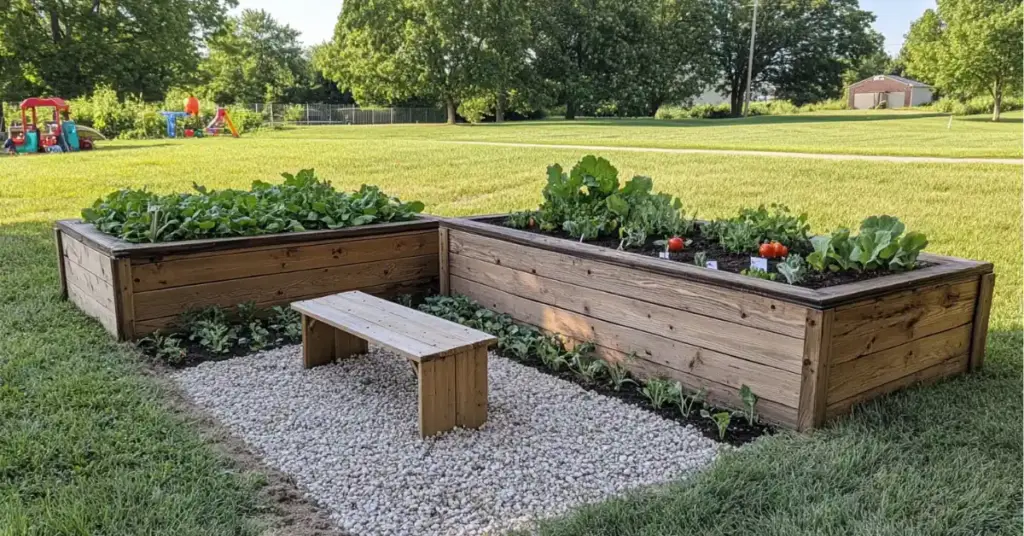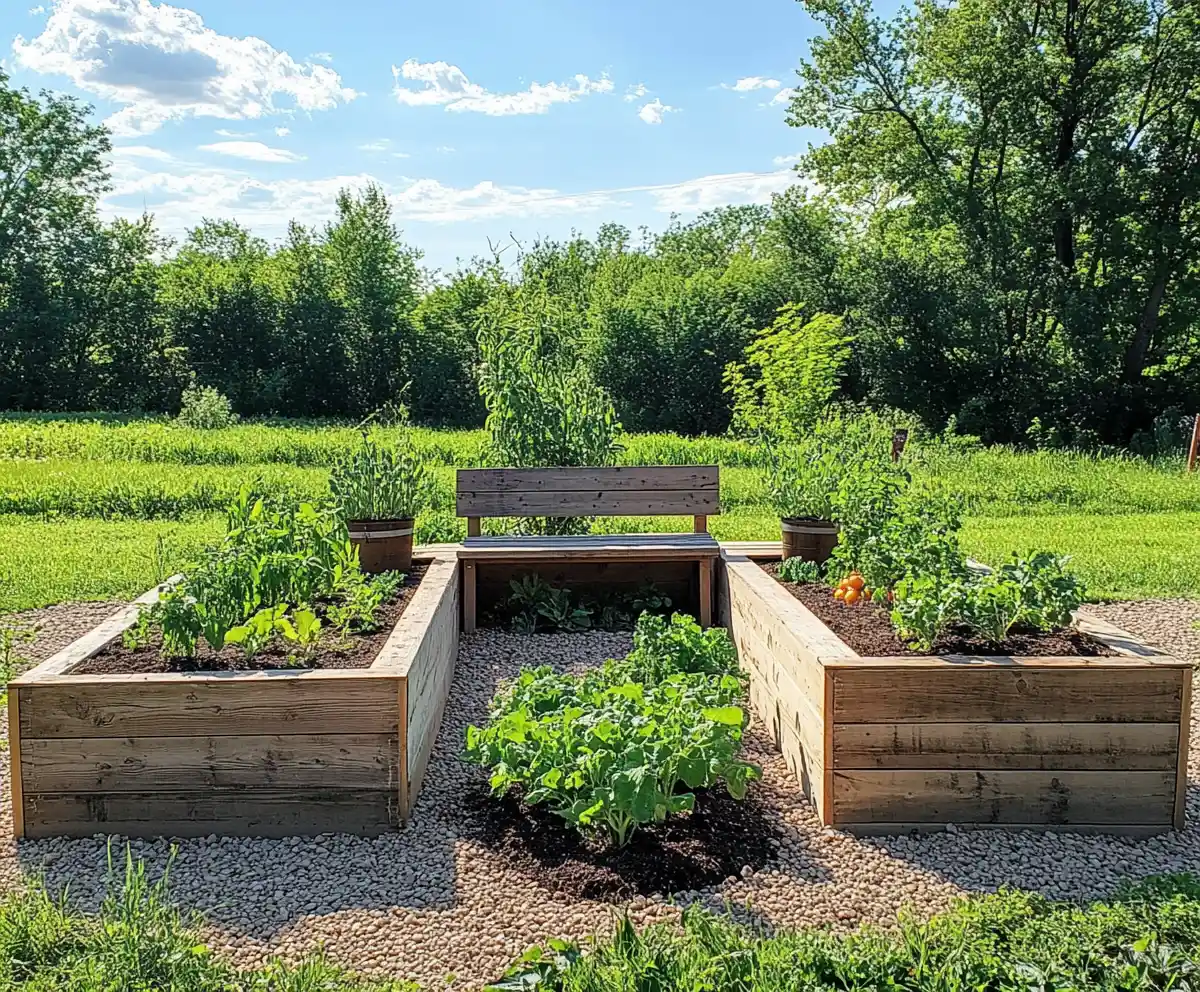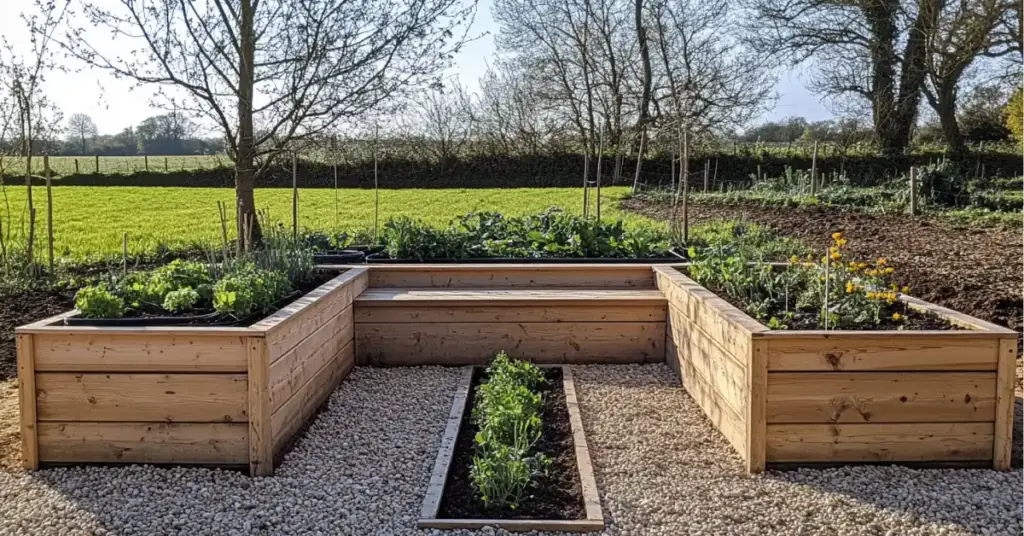Raised bed gardening has become a favorite among beginner and seasoned gardeners alike — and for good reason. Whether it’s the reduced weeding, improved soil structure, better drainage, or the polished look it adds to your yard, raised beds offer countless benefits. But if you’re new to this gardening style, it’s easy to stumble into mistakes that can cost you time, energy, and your harvest.
In this guide, we’ll walk through the most common raised bed gardening mistakes and how to avoid them, ensuring your garden thrives from the very first season. Whether you’re building your first bed or expanding your setup, these tips will help you make smarter choices and get the most from your space.
Table of Contents
1. Raised Beds That Are Too Wide Can Backfire
One of the biggest perks of raised bed gardening is protecting soil structure by avoiding foot traffic. But when your beds are too wide, you’re forced to step into them — and that defeats the purpose.
🌿 Why Width Matters
Soil compaction is a silent harvest killer. When you walk on garden soil, it compresses, reducing airflow and drainage. This makes it harder for roots to grow and for beneficial microbes to thrive. Raised beds are supposed to eliminate this issue, but only if you can reach every part of the bed without stepping inside.
✅ Ideal Raised Bed Dimensions
- Standard beds: 3 to 4 feet wide allows access from both sides.
- Against a wall or fence: Keep width under 30 inches so you can reach all the way across from one side.
You’ll thank yourself later when you’re weeding, planting, or harvesting without having to stretch awkwardly or tiptoe into your garden beds.
Pro Tip: Test your reach by stretching your arms across where your future bed will go. Comfort today means healthier plants tomorrow.
2. Skipping Irrigation Planning Leads to Major Headaches

It might seem easy enough to hand-water your garden in the beginning, but as the season goes on — and the heat kicks in — that watering can will start to feel like a burden. Proper irrigation is essential for a successful raised bed garden, and it’s something best planned before you plant a single seed.
💧 Why Irrigation Matters
Consistent watering is key to healthy growth. Raised beds tend to dry out faster than in-ground gardens due to better drainage and exposure. Without a solid irrigation plan, your plants may suffer from stress or inconsistent growth, especially during hot or dry spells.
🚿 Smart Irrigation Options for Raised Beds
- Soaker Hoses: Easy to lay out, budget-friendly, and water-efficient.
- Drip Lines or Drip Tape: Deliver water directly to plant roots, minimizing waste and disease risk.
- Garden Grids: All-in-one systems like the Garden in Minutes Grid offer precise, evenly spaced watering with minimal hassle.
🚫 Avoid Overhead Sprinklers
They may seem convenient, but sprinklers waste water and promote foliar diseases like blight and mildew. Wet leaves = sick plants.
Planning Tip: Place your beds near a water source to simplify setup. Installing irrigation after plants are established is not only awkward — it can also damage roots.
3. Using Unsafe or Short-Lived Materials for Your Raised Beds

Choosing the right material for your raised beds is about more than just cost or aesthetics. The wrong choice can impact plant health, garden safety, and how long your beds last. Not all wood — or alternative materials — are created equal.
🪵 What to Avoid
Pressure-treated wood made before 2003 contains arsenic and is unsafe for growing food. Always confirm the age and type of any repurposed wood before using it in your garden.
✅ Safe and Effective Raised Bed Materials
- Modern pressure-treated pine: Safe under current regulations, using copper instead of arsenic. It’s budget-friendly and long-lasting.
- Untreated pine: Inexpensive but breaks down quickly — ideal for temporary beds.
- Cedar or redwood: Naturally rot-resistant and chemical-free. Long-lasting but pricey.
- Reclaimed wood: Great for sustainability — just confirm it’s chemical-free and post-2003.
- Metal and stone: Sleek, durable, and rot-proof.
- BPA-free plastic beds: Lightweight, easy to assemble, and safe for edible gardens.
💡 Pro Tip
If you’re on a tight budget, check for free reclaimed wood in your area (like old fences or pallets), but always verify safety. When in doubt, build smaller beds with safer materials rather than risking a long-term issue with contaminated soil.
4. Using Low-Nutrient Soil Can Starve Your Plants
Raised beds give you control over your growing medium — but that also means it’s easy to get it wrong. One of the most common (and costly) mistakes is filling your beds with soil that lacks the nutrients plants need to thrive.
🛑 Why Bagged Soil Alone Isn’t Enough
Many beginner gardeners fill raised beds with potting soil or bagged mixes, assuming they’re sufficient. But these blends often:
- Drain too quickly
- Lack long-term nutrients
- Need constant fertilizing
This results in stunted growth, weak plants, and underwhelming yields.
🪴 The Best Soil Mix for Raised Beds
A rich, well-draining, nutrient-dense mix is key. Aim for:
- 50–60% native soil or quality topsoil
- 30–40% organic compost
- Optional: Add a small amount of vermiculite or coco coir for extra moisture retention
You can adjust based on local resources and budget, but avoid using all bagged soil unless it’s designed specifically for raised beds.
🌱 Ongoing Soil Health Tip
Top-dress your beds with homemade or store-bought compost each season. This adds organic matter, boosts microbes, and maintains long-term fertility.
Helpful Link Opportunity:
Consider linking to a soil mix recipe post or a composting guide for readers who want to DIY their blend.
5. Placing Raised Beds Too Close Together Makes Gardening a Chore

Spacing your raised beds might seem like an afterthought — until you’re wedging yourself between them to harvest squash or dragging a garden cart through narrow paths. Without adequate spacing, even simple tasks can become frustrating.
🔄 Why Bed Spacing Matters
Raised bed gardening should make your life easier, not harder. When beds are too close together, you’ll struggle with:
- Weeding and harvesting from the sides
- Moving wheelbarrows, stools, or carts
- Dealing with plants that sprawl over walkways
📏 Ideal Spacing Guidelines
- Minimum spacing: 2 to 3 feet between beds
- Wider if possible: For accessibility with tools or mobility aids
- Plan for plant sprawl: Tomatoes, squash, and cucumbers often overflow the edges
Proper spacing also improves airflow between plants, reducing the risk of disease and making maintenance much more manageable.
Pro Tip: Before installing your beds, test your layout with garden tools in hand. If your wheelbarrow or seat can’t fit comfortably, widen the paths.
6. Neglecting Pathways Leads to Weeds, Grass, and Even Pests
You’ve built your beautiful raised beds, but what’s happening in the space between them? If you ignore your pathways, you’re likely to end up battling weeds, invasive grass, or worse — hiding places for snakes and pests.
🌾 The Problem with Bare Pathways
Without a ground barrier, weeds and grass quickly take over. That means:
- Constant trimming or weeding
- Tripping hazards
- Unwanted guests like snakes or insects
- More time spent maintaining your walkways than your plants
✅ Easy, Low-Maintenance Pathway Options
Prevent overgrowth by laying a weed-blocking barrier before it becomes a problem. Here are some effective choices:
- Cardboard + mulch: An affordable, biodegradable combo
- Brown kraft paper + wood chips: Great for wide areas, easy to replace each season
- Sawdust: Not ideal near plants, but excellent for paths
- Pine needles: Slow to break down and look neat
- Gravel: Long-lasting, but place a barrier underneath to prevent weeds
🚫 Avoid Landscape Fabric
Although tempting, landscape fabric tends to fail over time — weeds grow through or around it. If you want a long-term solution, opt for greenhouse-grade plastic sheeting instead.
Pro Tip: Reapply mulch or sawdust each season to keep paths tidy and weed-free with minimal effort.
7. Skipping Mulch in Raised Beds Wastes Water and Grows Weeds
Many gardeners think raised beds don’t need mulch — but that’s a big mistake. Even though weed pressure might be lower than in-ground gardens, mulch is essential to keeping your beds low-maintenance and your plants thriving.
🌞 Why Mulch Matters in Raised Beds
Mulch isn’t just for looks. It plays a critical role in:
- Suppressing weeds: Especially those blown in by wind or dropped by birds
- Retaining moisture: Reduces the need for frequent watering
- Regulating temperature: Protects roots from extreme heat or cold
- Reducing soil erosion: Keeps nutrients where your plants need them
🌿 Best Mulch Options for Raised Beds
- Wood chips: Long-lasting, great for perennials and pathways
- Shredded leaves: Free and effective, though they break down quickly
- Straw (not hay): Light, easy to spread, and great for veggie beds
- Compost: Doubles as a nutrient booster while offering mulching benefits
💡 Mulch Tip
Apply a 2–3 inch layer and refresh it as it breaks down. You’ll spend less time watering and weeding — and more time harvesting.
Frequently Asked Questions (FAQ) About Raised Bed Gardening
1. What is the best size for a raised garden bed?
For ease of access and to prevent soil compaction, the ideal width is 3 to 4 feet if you can access the bed from both sides. If it’s placed against a wall or fence, keep the width under 30 inches. Length can vary, but 8 to 12 feet is common for manageability.
2. What is the best soil mix for raised beds?
A high-quality raised bed soil mix includes:
- 50–60% native or topsoil
- 30–40% organic compost Optionally, add coco coir, vermiculite, or perlite to improve moisture retention and drainage. Avoid using only potting soil or topsoil — they lack structure or nutrients on their own.
3. How deep should a raised garden bed be?
For most vegetables, a depth of 12 to 18 inches is ideal. Shallow-rooted crops can thrive in 6–8 inches, but deeper beds allow for better root development and soil health.
4. Do raised beds need a bottom layer?
If placing on soil, no bottom layer is required, but you can line the bottom with cardboard or newspaper to suppress weeds initially. For raised beds on concrete or decks, ensure proper drainage and consider a layer of gravel or coarse sand beneath your soil mix.
5. How often should you water a raised bed garden?
Watering depends on weather and soil mix, but in general:
- During hot months: Water 3–5 times per week
- Cooler seasons: 1–2 times per week Using drip irrigation or soaker hoses ensures deeper, more consistent watering.
6. Can I use mulch in raised beds?
Yes! Mulching helps retain moisture, reduce weeds, and regulate soil temperature. Use organic options like wood chips, straw, or shredded leaves for best results. Refresh mulch seasonally as it breaks down.
7. What vegetables grow best in raised beds?
Raised beds are perfect for:
- Leafy greens (lettuce, kale, spinach)
- Root veggies (carrots, radishes, beets)
- Tomatoes, peppers, bush beans
- Herbs (basil, thyme, cilantro)
Avoid very large plants (like corn) unless your beds are especially deep and wide.
Conclusion: Set Your Raised Bed Garden Up for Success
Raised bed gardening is one of the most rewarding ways to grow your own food — but only if you avoid common pitfalls that can limit your success. From choosing the right materials and soil to spacing your beds and managing weeds, each decision plays a role in creating a thriving, low-maintenance garden.
By planning ahead, investing in soil health, and implementing smart layout and watering strategies, you’ll enjoy healthier plants, bigger harvests, and a garden that truly works for you.
Ready to get growing? Keep learning, stay curious, and don’t be afraid to experiment — your best gardening season might just be the next one.


